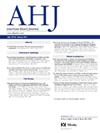急诊科疑似急性冠状动脉综合征的调查和管理中从传统肌钙蛋白检测过渡到高灵敏度肌钙蛋白检测的成本效益
IF 3.7
2区 医学
Q1 CARDIAC & CARDIOVASCULAR SYSTEMS
引用次数: 0
摘要
背景:将传统的心肌肌钙蛋白(hs-cTn)检测方法改为具有特定性别参考率的肌钙蛋白阈值检测方法,可以检测出较小的心肌损伤。然而,人们对这些检测方法对患者预后和医疗服务成本的实际影响知之甚少。我们调查了澳大利亚急诊科(ED)疑似急性冠状动脉综合征(ACS)患者改用 hs-cTn 检测方法并随访 12 个月的成本效益:利用九家三甲医院提供的 2011 年 3 月至 2015 年 11 月间 20 岁及以上疑似急性冠状动脉综合征急诊患者的关联管理数据,我们采用差异法比较了改用 hs-cTn 检测方法的医院与继续使用传统检测方法的医院之间的成本和主要不良心脏事件:我们确定了 179,681 名连续患者,其中 87,019 人在前期就诊,92,662 人在后期就诊。改用 hs-cTn 可降低指数事件的费用(-1,022 美元,95% CI:-1,034 美元,-1,009 美元),降低 12 个月的总费用(-1,373 美元,95% CI:-1,387 美元,-1,360 美元),降低 12 个月内出现 MACE 结果的患者比例(-0.55%,95% CI:-0.88%,-0.21%)。与所有患者和男性相比,女性患者的MACE结果减少幅度更大(-1.17%,95% CI:-1.19%,-1.14%):结论:对所有患者和不同性别的患者而言,改用 hs-cTn 具有很高的成本效益。女性患者在 12 个月内 MACE 后果和成本的降低幅度大于男性。本文章由计算机程序翻译,如有差异,请以英文原文为准。
Cost-effectiveness of the transition from conventional to high-sensitivity troponin assay for the investigation and management of suspected acute coronary syndrome in the emergency department
Background
Switching from conventional to high-sensitivity cardiac troponin (hs-cTn) assays with sex-specific reference rates for threshold troponin levels enables detection of smaller amounts of myocardial damage. However, the real-world impact of these assays on patient outcomes and health service costs is poorly understood. We investigated the cost-effectiveness of switching to hs-cTn assays for patients presenting to Australian Emergency Departments (EDs) with suspected acute coronary syndrome (ACS) with a 12-month follow-up period.
Methods
Using linked administrative data from 9 tertiary hospitals for patients aged 20 and above who presented to ED with suspected ACS between March 2011 and November 2015, we applied a difference-in-differences methodology to compare costs and major adverse cardiac events between hospitals switching to hs-cTn assays and hospitals continuing to use conventional assays.
Results
We identified 179,681 consecutive patients, of whom 87,019 presented during the preperiod and 92,662 the postperiod. Switching to hs-cTn was associated with a reduction in the cost of the index event (-$1,022, 95% CI: -$1,034, -$1,009), a reduction in total costs at 12 months (-$1,373, 95% CI: -$1,387, -$1,360) and a reduction in the percentage of patients experiencing a MACE outcome within 12-months (-0.55%, 95% CI: -0.88%, -0.21%). The reduction in MACE outcomes was larger for female patients (-1.17%, 95% CI: -1.19%, -1.14%) than for all patients and for males.
Conclusions
The switch to hs-cTn is highly cost-effective across all patients and for each sex. The reduction in MACE outcomes and costs within 12 months are greater for females than for males.
求助全文
通过发布文献求助,成功后即可免费获取论文全文。
去求助
来源期刊

American heart journal
医学-心血管系统
CiteScore
8.20
自引率
2.10%
发文量
214
审稿时长
38 days
期刊介绍:
The American Heart Journal will consider for publication suitable articles on topics pertaining to the broad discipline of cardiovascular disease. Our goal is to provide the reader primary investigation, scholarly review, and opinion concerning the practice of cardiovascular medicine. We especially encourage submission of 3 types of reports that are not frequently seen in cardiovascular journals: negative clinical studies, reports on study designs, and studies involving the organization of medical care. The Journal does not accept individual case reports or original articles involving bench laboratory or animal research.
 求助内容:
求助内容: 应助结果提醒方式:
应助结果提醒方式:


